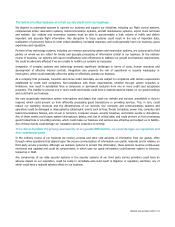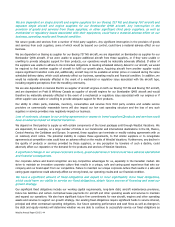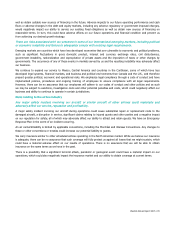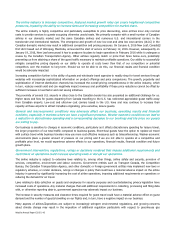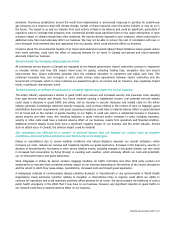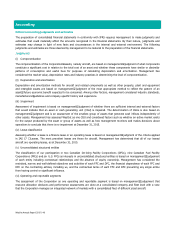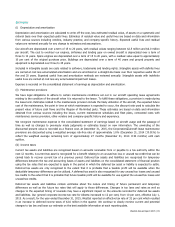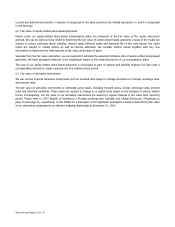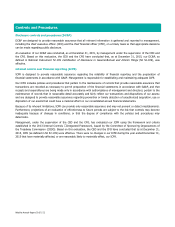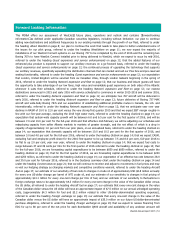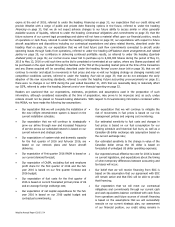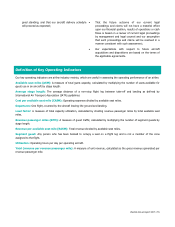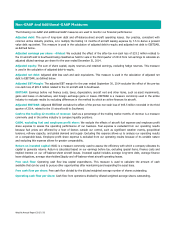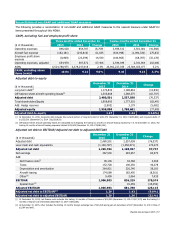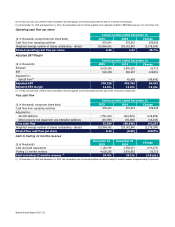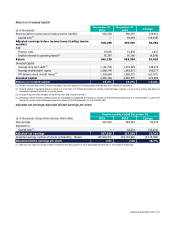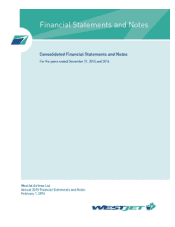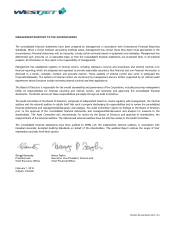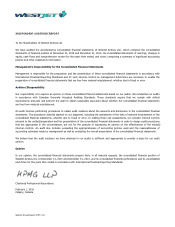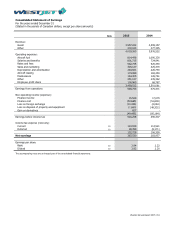Westjet 2015 Annual Report Download - page 55
Download and view the complete annual report
Please find page 55 of the 2015 Westjet annual report below. You can navigate through the pages in the report by either clicking on the pages listed below, or by using the keyword search tool below to find specific information within the annual report.
WestJet Annual Report 2015 | 53
Forward Looking Information
This MD&A offers our assessment of WestJet’s future plans, operations and outlook and contains “forward-looking
information” as defined under applicable Canadian securities legislation, including without limitation: our plan to continue
adding new destinations and additional frequencies to our existing markets through the growth of our fleet, referred to under
the heading
About WestJet
on page 8; our plan to continue the work that needs to take place to better understand some of
the issues for our pilot group, referred to under the heading
WestJetters
on page 11; we now expect the majority of
installations of our WestJet Connect systems on our Boeing 737 to be completed by the end of 2016 and the remaining two
Boeing 767s to have WestJet Connect installed prior to being delivered to WestJet, which we expect to occur by mid-2016,
referred to under the heading
Guest experience and service enhancements
on page 12; that the added features of our
enhanced plus product is expected to support our ancillary revenues on a go-forward basis, referred to under the heading
Guest experience and service enhancements
on page 12; the continued process of upgrading the technology that supports
our ancillary revenues, specifically expanding the distribution channels that can market and sell our Plus fare and pre-reserved
seating functionality, referred to under the heading
Guest experience and service enhancements
on page 12; our expectation
that London, United Kingdom will be serviced from six Canadian cities, through London Gatwick beginning in the spring of
2016, referred to under the heading
Network expansion and fleet
on page 12; that our business and leisure guests will have
the opportunity to take advantage of our low fares, high value and remarkable guest experience on both sides of the Atlantic
whenever it suits their schedule, referred to under the heading
Network expansion and fleet
on page 12; our newest
destinations announced in 2015 and early 2016 with service scheduled to commence in winter 2015-2016 and summer 2016,
referred to under the heading
Network expansion and fleet
on page 12; we anticipate two 767 aircraft will be delivered in
early 2016, referred to under the heading
Network expansion and fleet
on page 12; future deliveries of Boeing 737 MAX
aircraft and wide-body Boeing 767s and our expectation of establishing additional profitable routes in Canada, the U.S. and
internationally, referred to under the heading
Network expansion and fleet
on page 12; that we anticipate year over year
declines in RASM of 10.0 to 12.0 per cent versus the very strong first quarter 2015 and that we expect EBT margin roughly in
line with our five-year average, excluding the 2015 high water mark, referred to under the heading
Outlook
on page 14; our
expectation that system-wide capacity growth will be between 6.0 and 6.5 per cent for the first quarter of 2016, and will be
between 7.0 and 10.0 per cent for the full-year 2016 and that effective mid-February we will be adjusting our schedules and
redeploying capacity from softer Alberta markets to markets of greater strength, and the net effect of which is a drop in
capacity of approximately 1.0 per cent from our prior plans, on an annualized basis, referred to under the heading
Outlook
on
page 14; our expectation that domestic capacity will be between 10.0 and 10.5 per cent for the first quarter of 2016, and
between 3.0 and 4.0 per cent for the full-year 2016, referred to under the heading
Outlook
on page 14; that we expect CASM,
excluding fuel and employee profit share for the 2016 first-quarter to be up between 7.5 and 8.0 per cent, full-year 2016 to
be flat to up 2.0 per cent, year over year, referred to under the heading
Outlook
on page 14; that we expect fuel costs to
range between 47 and 49 cents per litre for the first quarter of 2016 referred to under the heading
Outlook
on page 14; that
for the full-year 2016, we are forecasting capital expenditures to be between $830 and $850 million, referred to under the
heading
Outlook
on page 14; that for the first quarter of 2016, we are forecasting capital expenditures to be between $240
and $250 million, as referred to under the heading
Outlook
on page 14; our expectation of an effective tax rate between 28.0
and 30.0 per cent for full-year 2016, referred to in the Guidance summary chart under the heading
Outlook
on page 14 and
under the heading
Income taxes
on page 21; that we will continue to monitor and adjust to movements in fuel prices and may
re-visit our hedging strategy as changing markets and competitive conditions warrant, referred to under the heading
Aircraft
fuel
on page 17; our estimate of our sensitivity of fuel costs to changes in crude oil of approximately USD $8.8 million annually
for every one US-dollar change per barrel of WTI crude oil, and our estimate of our sensitivity to changes in fuel pricing of
approximately $14.1 million for every one-cent change per litre of fuel, and our estimate of our sensitivity to fluctuations in
foreign exchange rates to be approximately $4.3 million for every one-cent change in the value of the Canadian dollar versus
the US dollar, all referred to under the heading
Aircraft fuel
on page 17; our estimate that every one-cent change in the value
of the Canadian dollar versus the US dollar will have an approximate impact of $7.5 million on our annual unhedged operating
costs, (approximately $4.3 million for fuel and $3.2 million related to other US-dollar-denominated operating expenses),
referred to under the heading
Foreign exchange
on page 19; our estimate that every one-cent change in the value of the
Canadian dollar versus the US dollar will have an approximate impact of $35.0 million on our future US-dollar-denominated
purchase obligations, referred to under the heading
Foreign exchange
on page 19; that we expect to receive financing from
EDC for up to 80 per cent of the net price for each Bombardier Q400 aircraft and availability of any undrawn amount will


